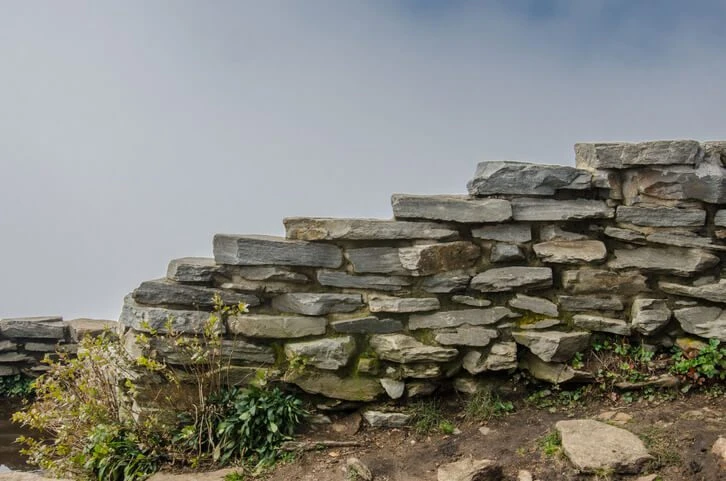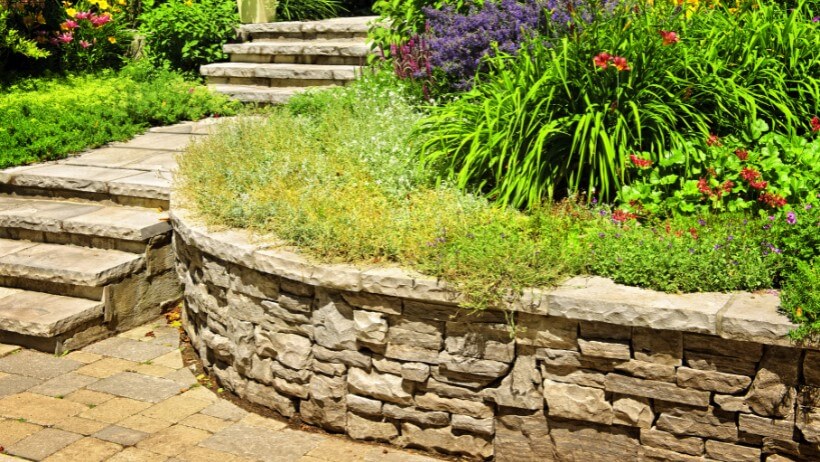Retaining walls are pivotal in landscaping and construction, offering functionality and aesthetic appeal. Beyond their primary role of soil containment, these structures are essential in preventing soil erosion and transforming sloped terrains into usable spaces.
Through strategic design and material selection, retaining walls secure landscapes against erosion and create valuable, functional areas out of steep inclines.
We will delve into the various types of retaining walls, examining their materials, construction methods, and the unique benefits each offers.
From gravity walls that stand firm through sheer mass to sophisticated anchored systems for challenging conditions, we’ll explore how these diverse solutions address specific landscaping needs while enhancing property value and visual appeal.

Factors to Consider When Choosing a Retaining Wall
Choosing the right retaining wall involves analyzing material choice, site conditions, aesthetic preferences, and budget. Each factor is essential for the wall’s effectiveness, durability, and integration with the landscape, ensuring functional and visual harmony.
Material Choices
Material selection impacts a retaining wall’s strength, durability, and aesthetic integration.
Natural stone offers versatility, precast concrete blocks and poured concrete ensure modern sturdiness, wood adds natural warmth, and bricks provide traditional charm. The choice should align with your landscape needs and aesthetic goals.
Site Conditions and Soil Types
Assessing site conditions and soil types is vital for planning and building a retaining wall. Considerations include soil’s weight-bearing capacity, drainage characteristics, and environmental impact risks.
These elements dictate the wall’s design, foundation, and potential need for reinforcements, ensuring durability and effective soil and water management.
Aesthetic and Design Preferences
A retaining wall’s design should complement the landscape and surrounding architecture.
Material and design choices significantly influence the wall’s aesthetic, ranging from rustic natural stone to sleek concrete fitting various styles. Selection should reflect personal taste and enhance your property’s appeal.
Budget and Longevity
Balancing budget and longevity is crucial. While natural stone is pricier, it may offer better durability and lower maintenance than wood or concrete blocks. Investing in durable materials can result in a longer-lasting wall, providing better long-term value by minimizing future costs and maintenance.
Types Of Retaining Walls: Different Retaining Wall Choices
#1 Gravity Retaining Walls
Gravity retaining walls utilize their mass to counteract soil’s lateral pressure, making them effective for slope stabilization and erosion prevention. They are built from heavy materials such as stone and concrete, relying on these elements’ weight for support.
These walls are versatile and suitable for garden landscaping and larger earth retention efforts. Their efficacy is linked to the weight of the construction materials and the gravity wall height.
By integrating engineering with the inherent strength of dense materials, gravity-retaining walls present a dependable solution for soil pressure management.
#2 Cantilevered Retaining Walls
Cantilevered retaining walls are engineered to leverage horizontal pressure from the soil itself to provide stability. This design, which includes a base slab and a thin stem, effectively uses the principle of leverage to hold back soil.
Constructed primarily from reinforced concrete or masonry, these walls are recognized for their strength and efficiency in various terrain conditions.
The cantilever retaining wall design allows for taller walls without additional reinforcement, making them a preferred choice for projects where space is limited but height is needed.
Their construction and material choice blend durability and architectural flexibility, catering to functional and aesthetic requirements.
#3 Sheet Piling Retaining Walls
Sheet piling retaining walls (Reinforced soil retaining walls) are ideal for soft soils and restricted spaces. They use vertically interlocked wood, vinyl, or steel planks driven deep into the ground. This method creates a tight barrier against soil movement, effectively securing the area.
The flexibility of the materials allows for the accommodation of various soil types and conditions, making sheet piling a versatile choice for waterfront properties, construction sites, and areas prone to erosion.
Their installation requires minimal space, offering an efficient solution for creating boundaries or preventing soil collapse in tight or challenging locations.
#4 Anchored Retaining Walls
Anchored retaining walls offer a unique solution for areas subjected to high loads or where wall thickness is constrained. These walls use mechanical anchors driven deep into the ground and connected to the wall, often through a cable or a rod, to provide additional support.
This method allows thinner walls to withstand greater pressures, making it an efficient choice for complex engineering projects or in situations where space is at a premium.
The anchors enhance the wall’s stability against earth pressures, making anchored walls versatile for both temporary and permanent structures.
Their construction can involve various materials, but the key to their effectiveness lies in the anchored support system that significantly increases the wall’s load-bearing capacity.
Innovative and Sustainable Retaining Wall Options
Green Retaining Walls
Green retaining walls represent an innovative approach to combining structural support with environmental sustainability. These walls incorporate vegetation and eco-friendly materials, promoting biodiversity while stabilizing soil.
Integrating plant life into the wall’s retaining structure prevents erosion, improves air quality, and creates habitats for various species. Using sustainable materials reduces environmental impact, making green walls a compelling option for eco-conscious projects.
Beyond their functional benefits, green retaining walls add aesthetic value. They blend seamlessly into natural landscapes and urban green spaces, underscoring the harmonious relationship between engineering and nature.
Gabion Baskets
Gabion baskets are an effective and visually appealing erosion control and landscaping solution. They consist of rectangular wire mesh boxes filled with rocks, concrete, or sometimes recycled materials and serve functional and decorative purposes.
The flexibility in fill material allows for creativity in design, while the structure provides significant erosion protection by dissipating water flow energy and stabilizing slopes.
Gabion baskets are praised for their durability, environmental friendliness, and ease of installation, making them popular in urban and natural settings.
Their use enhances aesthetic appeal with a natural look that blends well with various landscapes, contributing to their growing popularity in contemporary outdoor design.
Maintenance and Care for Retaining Walls
Routine Inspection and Cleaning
Consistent maintenance is essential to ensure retaining walls’ longevity and structural integrity. This encompasses routine inspections to detect potential issues early, such as cracks, bulging, or other signs of structural wear.
Regular cleaning to remove debris and inhibit vegetation growth on or near the retaining wall structure is crucial alongside these inspections. Such proactive care helps maintain the retaining wall’s aesthetic and functional aspects over time.
Repairing Damage
Retaining walls, while integral to landscape design and soil stability, are not immune to wear and tear. Common issues such as cracks and leaning can compromise their structural integrity and aesthetic appeal if not promptly addressed.
Cracks often result from natural settlement, excessive load, or water damage, signaling potential structural concerns. To repair cracks, you must first assess their depth and width. Minor cracks can typically be filled with epoxy or masonry crack filler.
At the same time, larger fissures might require a more comprehensive approach, such as installing additional reinforcement or even partial wall reconstruction.
Leaning, another prevalent issue, indicates a retaining wall failure in the wall’s ability to withstand the lateral pressure of the soil being retained.
The repair strategy for a leaning wall depends on the severity and cause.
Minor leaning might be corrected by improving drainage around the wall to reduce hydrostatic pressure or adding tiebacks for additional support.
More significant leaning cases, however, may require excavation of the affected area and the construction of a new wall designed to better accommodate the pressures exerted on it.
Preventative Measures
To enhance the durability and effectiveness of a retaining wall, it’s crucial to implement several preventative measures, particularly focusing on drainage and structural integrity. Here are key steps to consider:
- Ensure Proper Drainage: Implement and maintain an effective drainage system behind the wall to prevent water buildup, which can lead to hydrostatic pressure and structural damage.
- Choose Appropriate Materials: Select materials suitable for your climate and soil type, ensuring they can withstand the environmental conditions they will face.
- Regular Inspections: Conduct periodic inspections to identify and address potential issues early before they escalate into significant problems.
- Vegetation Control: Manage plant growth near the wall to prevent roots from disrupting the structure and ensure that water can freely move away from it.
- Immediate Repairs: Address any signs of damage, such as cracks or leaning, as soon as they are noticed to prevent further deterioration.
By following these steps, you can significantly prolong the life of your retaining wall and ensure it continues to serve its intended purpose effectively.
Conclusion
Choosing the right retaining wall for your needs and site conditions is crucial for your project’s long-term success and sustainability.
New Life Rockeries provides expert guidance and high-quality solutions, whether embarking on a new landscaping endeavor or looking to remedy an existing structure.
Our team of professionals is equipped to help you navigate the selection process, ensuring your retaining wall meets your functional needs and complements your aesthetic vision.
For a consultation or to learn more about our retaining wall contractor, visit New Life Rockeries today. Let us help you create enduring beauty and stability in your outdoor spaces.

